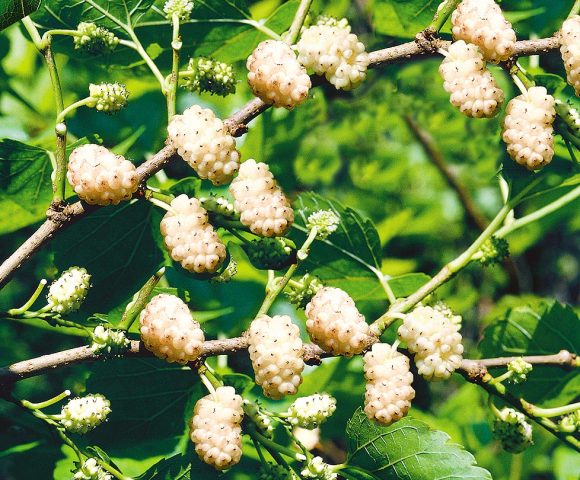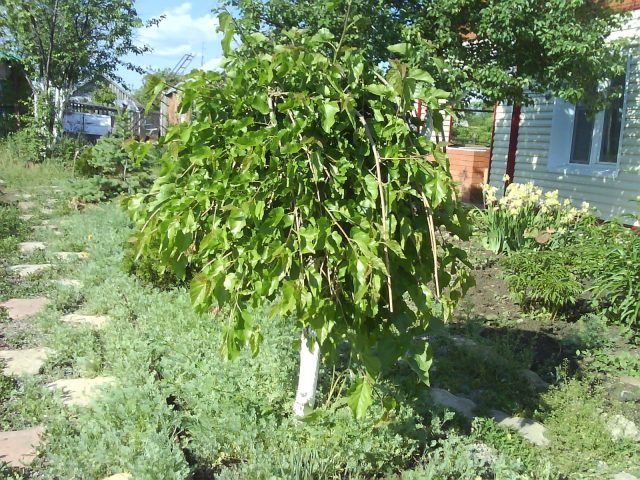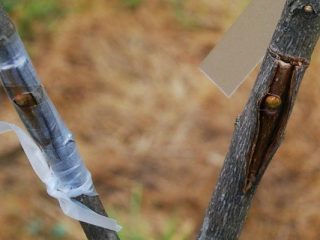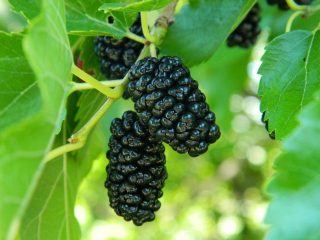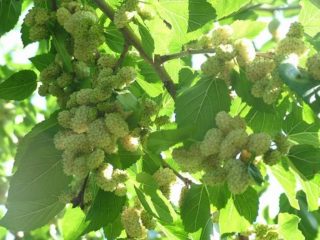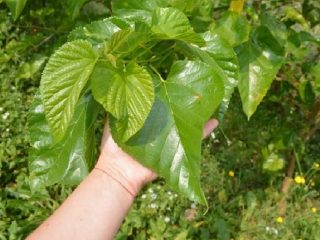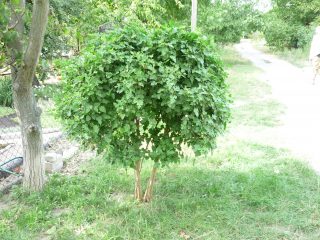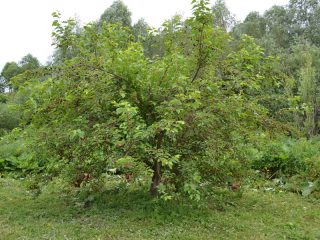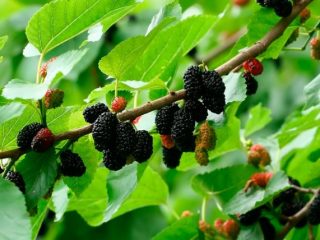Content
Mulberry Smuglyanka is loved by many gardeners due to its unpretentiousness; in addition, this variety is characterized by a high level of drought resistance. Smuglyanka mulberry is usually grown in the south to obtain a high yield of sweet fruits that children love so much. Today, mulberries grow throughout almost the entire territory of Russia. With proper care, you can get a good harvest.
Description of mulberry Smuglyanka
If we consider the description of the white mulberry Smuglyanka, it is worth noting that this variety was obtained in the process of selecting the best samples of white mulberry.
The Smuglyanka mulberry tree is deciduous, with a crown of moderate density in the shape of a ball. The plant can reach a height of 3 to 15 m. At first, the mulberry grows quite quickly, but gradually the growth slows down. The flowers appear dioecious; as a rule, they are collected in spikes. The leaves are quite large and wide, the edges are jagged and rough to the touch. In summer, the foliage of the Smuglyanka mulberry is completely green, but towards autumn it begins to turn yellow.
The berries resemble blackberries in appearance and come in a variety of shades.Mulberry Smuglyanka has white fruits. The fruits can be eaten, the size is about 2-3 cm, the berries have a pleasant aroma.
Pros and cons of the mulberry variety Smuglyanka
If we consider the advantages of this variety, it is worth noting the following points:
- White Smuglyanka is a winter-hardy mulberry variety;
- unpretentiousness to the soil;
- annual fruiting;
- resistance to pests and diseases;
- high level of productivity with proper care;
- the versatility of the fruit (can be used for preservation or eaten fresh);
- shelf life is 12 hours;
- sweet taste of fruits;
- pleasant aroma (in some cases it may be absent).
Among the disadvantages, some gardeners note the fact that the fruits are quite difficult to collect due to their small size. In addition, despite the fact that this variety is able to tolerate low temperatures, the Smuglyanka mulberry needs shelter for the winter, otherwise the yield will be significantly reduced.
Planting and caring for Smuglyanka mulberries
As many experienced gardeners note, the Smuglyanka mulberry variety is an unpretentious species. This plant quickly adapts to new growing conditions. In order to obtain a high level of yield, it is necessary to provide high-quality care for the Smuglyanka mulberry. It is necessary not only to choose the right planting material and place for planting, but also to apply fertilizers during the growth of the mulberry, form a crown, and cover it for the winter.
Preparation of planting material and site
When choosing a site for planting Smuglyanka mulberries in open ground, it is recommended to give preference to places with good lighting. The optimal solution would be loose loamy or sandy soils. In this case, you need to take into account the fact that the plant can live up to 300 years.
As a rule, planting material begins in early spring or late autumn. In order for the seedlings to take root better, you need to purchase a rooting agent for the root system, dilute the solution and place the planting material in it for several hours, and only then begin planting in open ground.
Landing rules
The pit must be prepared in advance, its dimensions should be 80*80*60 cm. The planting process is as follows:
- The removed top fertile layer is poured onto the bottom.
- Humus is added.
- Fertilizers – 150 g.
- A seedling is planted in the center of the hole, and it is necessary to carefully straighten the root system without damaging it.
- After planting, the plant is watered and the ground around is mulched, which will prevent the appearance of weed.
At the moment of intensive growth, fertilizers are applied. In early July, watering is possible only if there is a drought.
Watering and fertilizing
The key to any healthy plant and high yield is not only proper planting and propagation, but also the process of watering and fertilizing.
It is recommended to water the Smuglyanka mulberry starting in early spring and continuing until July. Particular attention should be paid to watering in dry weather. In the spring you need to fertilize. For these purposes, nitrogen fertilizers are usually used. In summer, it is worth giving preference to potassium and phosphorus fertilizers.
Trimming
Mulberries of the Smuglyanka variety should be pruned during a period of complete or partial dormancy. The most optimal solution would be to carry out pruning work at the end of April or at the beginning of May, at a time when the movement of juices has not begun and the buds have not blossomed. At such moments, formative or rejuvenating pruning is performed.
Sanitary pruning is carried out in the fall, when the growing season has come to an end and the temperature is not lower than -10°C. In this case, all diseased and damaged branches must be removed.
Preparing for winter
Mulberry Smuglyanka is able to tolerate low temperatures down to -30C. Despite this, the tree often suffers from a lack of heat, as a result of which the yield is significantly reduced. In the spring, it is necessary to remove all frostbitten branches; new ones will appear over the summer.
To make it more convenient to cover the plant, it is pruned and the crown is given the shape of a ball. When the first frosts appear, the mulberry tree is covered with burlap and tied with twine. If necessary, you can use a padded jacket. With the onset of warmth, the shelter is removed.
Harvesting
It is important to take into account that the Smuglyanka mulberry has a rather extended fruiting period, as a result of which the fruits ripen over 1.5-2 months. Since ripening is uneven, one branch can contain both green berries and ripe ones, ready for consumption.
The berries are small in size, but there are quite a lot of them. Since fruits cannot be stored for a long time, some experienced gardeners save the time allotted for harvesting.For these purposes, they spread a film under the tree and start shaking it.
Diseases and pests
Mulberry Smuglyanka is a plant resistant to a number of diseases and pests. In central Russia, plants suffer much more from low temperatures than from diseases. Diseases to which mulberries are susceptible can be divided into fungal and viral:
- powdery mildew;
- brown spot;
- root rot;
- bacteriosis;
- tinder – a mushroom that feeds on nutrients from trees;
- curly small-leaved is an incurable virus caused by sucking insects.
In addition, you should be afraid of American butterflies, which can leave the tree completely without foliage. In this case, when nests are discovered, it is necessary to cut them off along with the branches.
Reproduction
In addition to describing the mulberry variety Smuglyanka, it is important to know how this variety reproduces. Reproduction is carried out in the following ways:
- seeds. In October, it is necessary to clear the pulp from the berries from the current year's harvest and soak the seed for 2 hours in a solution of a growth stimulator for the root system;
- cuttings. This method is considered the most labor-intensive, since it is necessary to create suitable conditions for planting material in the greenhouse. When propagated by cuttings, the Smuglaya mulberry takes on all the maternal characteristics;
- offspring. If the plant has been damaged, shoots begin to appear in this place, as a result of which the plant itself prevents its further death. If necessary, excess shoots can be cut off and rooted;
- graft. As a rule, you can graft the Smuglyanka mulberry using any convenient methods, but the most popular is copulation.
Thanks to such a wide selection, every gardener will be able to determine the most convenient and easiest way to propagate mulberries.
Reviews of mulberry Smuglyanka
Conclusion
Mulberry Smuglyanka has gained such popularity due to its unpretentiousness and juicy fruits. Despite the fact that the berries are versatile and can be eaten, some designers use mulberries to decorate a plot of land.
